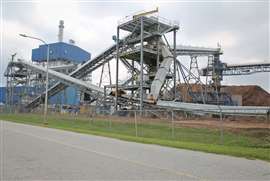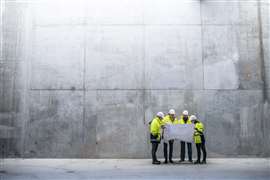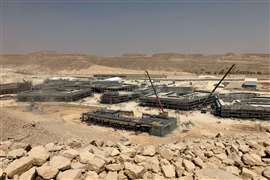Read this article in Français Deutsch Italiano Português Español
Could the drive to decarbonise military forces present an opportunity for construction companies?
08 February 2024
As some of the world’s biggest militaries start to look at ways to cut their carbon emissions, could there be opportunities for construction companies?
 The US Pentagon building. Research found the Department of Defense structure produces more than 24,000 metric tonnes of carbon dioxide equivalent. (Photo credit: Adobe Stock)
The US Pentagon building. Research found the Department of Defense structure produces more than 24,000 metric tonnes of carbon dioxide equivalent. (Photo credit: Adobe Stock)
Some of the biggest emitters of carbon dioxide are the world’s military forces.
Given the vast range of personnel, land and buildings, and vehicles and industrial equipment they oversee, that probably comes as no surprise.
Among the world’s biggest consumers of fuel, militaries account for 5.5% of global greenhouse gas emissions, according to a 2022 estimate.
Some are now starting to wake up to their environmental responsibilities.
Last year, for example, the US Department of Defense published a plan to reduce greenhouse gas emissions.
France’s military is the biggest contributor to greenhouse gas emissions in Europe and it too has developed a ‘climate and defence strategy’ published in 2022. Meanwhile, the UK government now measures its ‘defence carbon footprint’, estimated to be 13 million tonnes of CO2 equivalent (tCO2e), as of 2020. Last year, a group of MPs also urged the military to decarbonise, in a new report.
The initiatives should pique the interest of North American and European contractors and firms, as some of the world’s biggest militaries are set to spend billions on infrastructure improvement in the coming decades.
US focus on modernising infrastructure
In the US, the Department of Defense (DoD) is responsible for a considerable majority of the federal government’s total energy consumption. In 2018, the entire U.S. government used roughly 900 trillion British thermal units (BTUs) with the DoD responsible for 750 trillion of those BTUs.
 The Marine Barracks complex is one of the oldest government buildings in continuous use in Washington D.C. (Image: JHVEPhoto via AdobeStock - stock.adobe.com)
The Marine Barracks complex is one of the oldest government buildings in continuous use in Washington D.C. (Image: JHVEPhoto via AdobeStock - stock.adobe.com)
Fuel used in conflict may be the biggest driver of emissions problem, but it’s by no means the only one.
The majority of the 750 trillion BTUs the DoD used went on jet fuel (roughly 400 trillion BTUs annually). But the next biggest contributors were diesel fuel (roughly 100 trillion BTUs annually) and electricity (roughly 100 trillion BTUs annually). Here is where construction companies could help with modernising infrastructure.
“The immense energy demand from DoD buildings creates an increased dependence on commercial grids. This energy dependence creates mission risks due to potential disruptions from extreme weather, grid issues, cybersecurity attacks and other unforeseen risks while simultaneously creating undue strain on the local energy serving critical infrastructure,” said the DoD’s Defense Innovation Unit (DIU). “This strain is magnified due to the age of DoD’s existing building stock; the majority of which was built between 1940 and 1990.”
According to the US government, the Department of Defense’s real estate portfolio is one of the world’s largest. It owns more than 500,000 buildings and structures at more than 500 sites, comprising millions of acres of land spread throughout the US and more than 30 other countries.
The DIU announced in January 2024 that it was seeking proposals for net-zero construction projects at DoD sites. Via official solicitations for projects, the DIU was specific in its methodology for reducing its carbon output.
“Buildings and their supporting systems [like] lighting [and] HVAC have a significant impact on energy use and the environment,” said DIU. “Commercial and residential buildings use approximately 76% of all electricity and are responsible for 40% of greenhouse gas emissions in the United States. Much like the private sector, the DoD’s building stock is one of the single greatest drivers of energy and water demand.”
All told, it’s an overhaul for the DoD, as they’ll seek contractors in nearly every sector of the construction industry to find a leg-up on bringing emissions down.
The agency is also requesting vendors with methods to improve energy and water efficiency in newer or yet-to-be-built DoD facilities.
Language in the solicitation suggests the scope of projects is vast.
“Solutions should be adaptable for diverse geographical locations, both domestic and international, and for one or more types of buildings, including: administrative, housing and community, barracks, supply, research, development and testing, maintenance and production, hospital and medical, and any other type of facility located at a DoD installation,” said DIU.
US Air Force sets out net-zero plans
In January 2024, the US Air Force unveiled its plans to achieve net-zero by the 2050 deadline.
Per a pre-solicitation notice, the Air Force stated it seeks “responses from architectural and engineering firms for an Indefinite Delivery Indefinite Quantity Multiple Award Task Order Contract to provide Title I design, Title II construction phase support services, and other related services in support of Executive Order 14057.
The military branch said it anticipates the contract ceiling for net-zero projects to surpass US$2 billion (€1.84 billion).
Services sought include demolition of existing facilities, sustainment and modernisation of existing facilities, and the construction of new facilities. News reports suggest the Air Force, and other DOD entities, will seek firms using carbon-capture materials and design strategies that promote long-term sustainability.
Responses to the Air Force work notice are due by 2 February and the Air Force plans to release a synopsis for the contract during either the second or third quarter of this calendar year.
US Marine Corps’ net-zero facility
 A US Marine Corps facility in Albany, Georgia, US. (Photo credit: US Marine Corps)
A US Marine Corps facility in Albany, Georgia, US. (Photo credit: US Marine Corps)
One net-zero facility is already in operation, in Albany, Georgia, US, and it’s believed to be the first of its kind in the country.
Media reported that the Marine Corps Logistics Base Albany – in the rural southwest section of the state – achieved its net-zero goal last year.
The facility generates electricity from natural gas captured at a nearby landfill, and also gets power from tree bark and sawdust collected from a neighbouring paper plant.
While still a test project for the US military, early returns have been positive. The Marine Corps said “going green” has helped increase effectiveness at the facility, as it is less dependent on finicky fossil fuel supply lines.
UK, US forces exploring alternative fuels
While the US tackles sustainability on the infrastructure front, the UK Ministry of Defence has focused on using alternative fuels on the battlefield.
Since late 2022, UK military aircraft have been testing sustainable aviation fuel (SAF) in their systems. Air Chief Marshal Sir Mike Wigston noted the Royal Air Force (RAF) plans to be the world’s first net-zero Air Force by 2040.
The Ministry of Defence in the UK is also continuing with efforts to develop an all-electric fleet of military vehicles. In 2023, Babcock International announced that it had a contract to re-engineer four British Army Land Rovers to integrate an electric propulsion system.
While there do not yet appear to have been similar initiatives related to military construction equipment, it indicates the direction of travel.
Global military net-zero plans
While the US, UK and EU countries have largely held the torch on climate change progress in their respective militaries, leadership across the globe has (albeit slowly) started to list net-zero and sustainability goals.
Joining their allies in achieving military-specific net-zero goals by 2050 are Canada and Australia.
Jonathan Lussier, a US Naval Postgraduate School faculty associate, in a report titled Net-Zero Planning by Militaries Across the Globe, noted most countries are still “catching up.”
“Most EU, NATO and other allied countries have goals to become net zero by 2050 with public policies and statements showing a reliance on a combination of technologies and other strategies to reach the goal,” he wrote. “There is little public documentation in many of these countries on military specific goals and technology strategies.”
Particularly based on military size and overall population, Lussier noted three countries – India, China and Russia – that have delayed plans or stayed mum on net-zero military transformation goals.
“In part due to India’s developing state, it is lagging behind most other countries in net-zero goals,” he stated. “In 2022, the Indian prime minister announced a 2070 goal for net zero. This goal may be subject to change as India continues to develop, but it is possible there will be a time window of compatibility issues for international interoperability while Indian forces continue to use fossil fuel-based energy after other countries have transitioned.”
Russia and China, Lussier said, have made little action in the sector.
“Neither China nor Russia have shown intention, at least publicly, to reach net zero,” he said. “China has a goal to be net zero by 2060, but research shows little supporting information or action. Russia has been inconsistent with both goals and any policies showing intent.”
STAY CONNECTED


Receive the information you need when you need it through our world-leading magazines, newsletters and daily briefings.
CONNECT WITH THE TEAM











